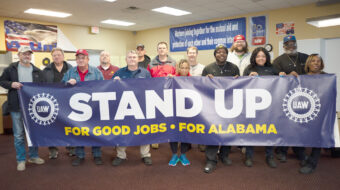WASHINGTON – There’s a very simple way for employers to avoid having their workers keel over from heat exhaustion or die from heat stroke as temperatures rise this summer, says Occupational Safety and Health Administration chief Dr. David Michaels. It’s a formula to follow with three little words: “Water, rest, and shade.”
Use those measures to protect your workers, OSHA’s campaign adds, and you won’t be among the firms that saw approximately 4,000 workers collapse – and 40 die – from heat exposure in 2010 (as data from that year shows).
That slogan is at the heart of the agency’s drive, launched May 7. It’s timely because the summer construction and agriculture season is headed towards full swing and those two fields are the ones with the highest exposure of workers to heat dangers.
But they’re not the only ones, Michaels told a telephone press conference. Other “extremely vulnerable” workers include roofers, highway workers, oil and gas workers, and those starting outdoor jobs for the first time. He recommended those first-timers ease into the tasks.
Firms can avoid exposing workers to extreme heat by rescheduling tasks to early morning or late evening, when heat is less intense. They should provide rest breaks, plenty of shade, and a shady area for quickly covering a worker who shows signs of heat stress. And they should provide lots of water and require workers to drink it every 15 minutes “even if they don’t feel dehydrated,” Michaels, a public health specialist, said. And workers should watch out for each other for signs of heat stress, he added.
By and large, Michaels said, employers are eager to cooperate in protecting workers from excessive heat, though the United Farm Workers has repeatedly cited California growers for excessive heat exposure for workers. Indeed, the problems in California led to an advanced state heat stress prevention program there, which OSHA took as its model, Michaels said.
OSHA is using all methods it can to get the message out, in both English and Spanish, since Spanish-speaking workers, due to language barriers, are more vulnerable to exploitation and heat exhaustion. Its communications channels include its website – with an anti-heat page – radio spots, contacts with churches, community groups, and Latin American consulates, staff seminars for employers, and flyers.
And Michaels made the point that deaths from heat stress may be higher than the figures show. “We know from epidemiological studies that if someone works outside in the heat all day, then goes home and dies of a heart attack, we know that the death is heat-related, but it’s not recorded as that,” he said.












Comments